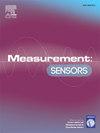Beam divergence errors in unbalanced laser interferometers – Case study with a free-fall absolute gravimeter FG5X
Q4 Engineering
引用次数: 0
Abstract
Laser interferometers play a key role in high-precision length measurements. One source of error in such a measurement is the relative length error induced by the divergence angle due to laser collimation. Often the error is calculated by the formula of Dorenwendt and Bönsch, which, however, is strictly valid only for balanced interferometers and negligible travel ranges. Free-fall absolute gravimeters, such as FG5(X), contain a highly unbalanced interferometer. This requires a further correction, which has a non-negligible contribution for large beam divergence angles, or equivalently, small beam waists.
Here we present a high-accuracy method for the determination of the beam divergence error in unbalanced laser interferometers. First, we determine the beam parameters of a beam exiting a collimator, by means of a Shack-Hartmann sensor. Then, we calculate the relative length error with a revised correction formula. Finally, we perform absolute gravity measurements with an FG5X, and compare our results to our theoretical predictions. As a result, we get a relative length error in the order of for a commercial Thorlabs TC25APC-633 triplet collimator, which is comparable with the built-in collimators of FG5(X) gravimeters. The outcome is also applicable to other interferometer setups. In special, the findings are important for the realization of the SI unit kilogram via the Kibble balance method.
非平衡激光干涉仪中的光束发散误差-自由落体绝对重力仪FG5X的案例研究
激光干涉仪在高精度长度测量中起着关键作用。这种测量误差的一个来源是由激光准直引起的发散角引起的相对长度误差。通常误差是通过Dorenwendt和Bönsch的公式计算出来的,然而,这个公式只对平衡干涉仪和可忽略的行程范围严格有效。自由落体绝对重力仪,如FG5(X),包含一个高度不平衡干涉仪。这需要进一步的校正,这对于较大的光束发散角或较小的光束腰有不可忽略的贡献。本文提出了一种高精度测量非平衡激光干涉仪光束发散误差的方法。首先,我们利用Shack-Hartmann传感器确定出准直器的光束参数。然后,利用修正后的修正公式计算相对长度误差。最后,我们用FG5X进行了绝对重力测量,并将结果与理论预测进行了比较。结果表明,商用Thorlabs TC25APC-633三重态准直器的相对长度误差为−2.8·10−9,与FG5(X)重力仪的内置准直器相当。结果也适用于其他干涉仪的设置。特别地,这些发现对于通过基布尔平衡法实现国际单位制单位千克具有重要意义。
本文章由计算机程序翻译,如有差异,请以英文原文为准。
求助全文
约1分钟内获得全文
求助全文
来源期刊

Measurement Sensors
Engineering-Industrial and Manufacturing Engineering
CiteScore
3.10
自引率
0.00%
发文量
184
审稿时长
56 days
 求助内容:
求助内容: 应助结果提醒方式:
应助结果提醒方式:


